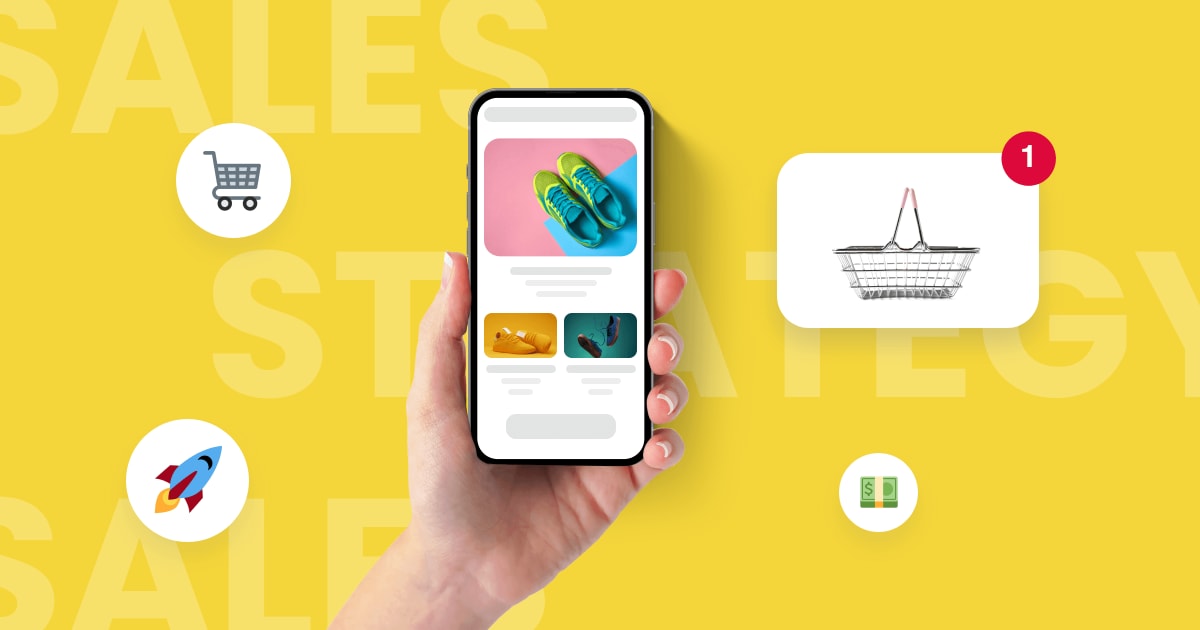Gain valuable insights into the future of the eCommerce industry. Read the article to explore tomorrow's lead generation methods.
Table of contents
E-commerce has totally changed how people buy and sell. Technology keeps advancing, and people keep changing how they shop online. And it’s an exciting time to be a part of this digital revolution, and who knows what the future holds for eCommerce? We’ve got some guesses.
Interested in learning more?
Keep reading to explore the dynamic eCommerce environment and discuss the trends that will shape the way marketers capture and nurture potential customers.
The evolution of e-commerce
Did you know that globally, retail e-commerce sales were expected to reach 5.7 trillion dollars in 2022? It’s a big number. It wouldn’t be possible without the rapid evolution of ecommerce technology.
First, let’s jump into some basics and check out how it happened.
Traditional eCommerce landscape
➡️ What’s ecommerce?
E-commerce is all about buying and selling online, just like you would at brick-and-mortar stores, but without leaving your couch. Also, it used to be all about setting up an ecommerce store and hoping people would find it.
Here are major business models of ecommerce:
- business-to-consumer (B2C)
- business-to-business (B2B)
- consumer-to-consumer (C2C)
- consumer-to-business (C2B)
just to name a few.
➡️ How did e-commerce get started?
It all started in 1991 with the internet becoming commercially available. Then, protocols like HTTP and DSL were implemented to secure electronic transactions. Many of the companies collapsed, but also many of them achieved great success in online shopping.
For example, platforms like Amazon. According to the research, this ecommerce website made almost 514 billion U.S. dollars in ecommerce sales in 2022.
➡️ Basic lead generation techniques used in traditional ecommerce
Email marketing was and is one of the most popular ways of capturing leads. Ecommerce companies collect email addresses from interested buyers and send them appealing newsletters and promotions.
SEO services plays a role for new ecommerce businesses as well. Online sellers put a lot of effort into ranking high in search engine results and often hire agencies to help. Agency experts use strategic keywords, catchy product descriptions and write excellent blog posts to attract those organic leads.
Although it’s considered traditional, these lead generation techniques are still effective in attracting new customers.
But things have evolved, and it’s got way more advanced.
Now online shopping is faster, smoother, and more fun than ever. And technology is a major factor in this evolution. We’ve seen the rise of mobile commerce, where everyone is using their phones to shop on the fly.
The rise of advanced technologies
If you were to tell people 30 years ago: you can browse, compare prices, click the “buy now” button, and have your order at your front door the next day. And there’s nothing tricky around it, people wouldn’t believe you.
Nowadays, online shopping is a convenient way to buy things without ever leaving a house.
It’s all possible with the newest technology available at hand. And let’s not forget the power of social media platforms. It’s not just for scrolling through random pics anymore. This is a goldmine for businesses.
They’re using social media to connect, engage, sell, advertise, and even sale. Thanks to algorithms and machine learning, they figure out customers’ preferences, predict their next move, and show you ads that are perfectly tailored to them.
What’s more, you have a direct connection to your favorite brands. You can follow them, check out their latest products, and even make purchases right there in the app. It’s mobile socializing and shopping at the same time.
The intersection of e-commerce and AI
Online sellers use artificial intelligence. And these technologies are truly revolutionizing eCommerce.

AI and machine learning entering handle massive amounts of data and generate super useful insights. They know what we want before we even know it ourselves.
And undoubtedly, AI and online selling is an effective duo. AI helps ecommerce companies personalize their online shopping experience like never before.
Also, thanks to this new technology, businesses are able to automate most of their mundane tasks. For example, using chatbots and their omnichannel capabilities for customer service.
The future of eCommerce
Selling online does not stop. With technological development, ecommerce is getting better, more convenient, and seamless for buyers. Let’s see what will make the online industry even stronger in the future.
Personalization in eCommerce
Machine learning and the technology behind it analyze our shopping habits, predict our preferences, and serve up personalized recommendations.
And what works better than tailored offers presented directly to shoppers? When looking for certain products, prospects may see the suggested products that probably fit their style. Besides that, they offer them irresistible discounts or free shipping or the buy one get one for free deals.
The more a potential buyer interacts with an ecommerce website, the more improved recommendations they’ll get.
And this is where customer satisfaction increases. With personalized offerings, online retailers keep visitors:
- browsing
- buying
- and coming back
Then online sellers take a customer-centric approach, which builds trust and loyalty and generates new leads.
Integration of Augmented and Virtual Reality
What do you think about virtually visualizing furniture in your living room, test-driving a car from the comfort of your own home, or trying out a product before buying? Quite impressive, isn’t it? It’s thanks to virtual reality (VR) and augmented reality (AR).
This branch of new technology is also very powerful in lead generation. Again, it’s based on a customer-centric approach making it possible to connect with potential customers and increase sales.
➡️ What’s the difference between AR and VR?
The difference between those two is that AR works using real-world settings while VR is focused on a virtual environment.
➡️ How do AR and VR technologies impact ecommerce lead generation?
An ecommerce business may create immersive VR and AR experiences that capture attention and spark curiosity in prospects.
Interactive product demonstrations, virtual try-on sessions, and personalized shopping journeys will make the lead-generation process more exciting and memorable.
But exceptional customer experience is not the only asset. Customers’ behaviors, preferences, and purchasing patterns can be better understood. You analyze interactions with virtual environments from a totally different angle.
So… get ready for thrilling shopping experiences and interactive product demonstrations. Why not get a glimpse of products on your screen with VR and AR?
Blockchain in e-commerce
Reliable blockchain equals a solid foundation of trust, where customers can feel confident in their purchasing decisions, and businesses can attract qualified leads.
➡️ What is a blockchain in ecommerce?
The blockchain is an ultra-secure digital ledger that tracks all transactions within an online marketplace (like Amazon). But not only. It refers to the ecommerce websites that handle online transactions.
Using blockchain technology, e-commerce platforms may improve payment processes, protect data, and make transactions more reliable and efficient.
➡️ Why is blockchain so important in ecommerce?
In ecommerce, secure transactions are key. If online businesses cannot guarantee that their payment system is trustworthy, they risk losing the credibility and loyalty of potential customers.
Online scams and data breaches are a thing nowadays. Customers are becoming more cautious about sharing their sensitive financial information. This is why businesses profit from prioritizing the implementation of robust security measures to safeguard customer payment transactions.
Blockchain also opens up exciting possibilities for secure and decentralized marketplaces. It also eliminates the need for third parties. Then, businesses to directly connect with buyers, reducing transaction costs and generating leads more effectively.
Mobile commerce
Mcommerce revenue keeps growing year after year. In the United States, mCommerce spending made up 38% of total digital sales. What’s more, it’s expected to grow.

Shopping on the go is fast, hassle-free, and can be done wherever and whenever. With mCommerce on the rise, businesses must upgrade their mobile experiences.
A well-optimized and easy-to-navigate website is a must when companies want to turn visitors into qualified leads.
Mobile users want things fast, and a slow-loading site isn’t gonna keep them around. In case your site gets overlooked in this matter, it’s a friendly reminder to catch up.
For instance, check on mobile-optimized payment options and voice search to provide a great e-commerce experience.
📰 Learn more about boosting product sales in e-commerce.
Voice commerce
Using voice commerce, consumers can make purchases using their voices. This innovative technology stands out for its seamless integration of virtual assistants. When customers have their hands busy or just are unable to type, then voice commerce comes in handy.
Social commerce
Social commerce is making purchases directly on social media platforms. And it’s stealing the spotlight in the e-commerce industry. Online shoppers make nearly 29% of their purchases directly on platforms.
Online customers can make purchases without ever leaving an app. Only a few taps set them apart from getting their social-media finding delivered to their doorstep.
The implications for lead generation in 2024 and beyond
Ecommerce is completely different from traditional commerce, so it takes different measures. And those measures may bring a lot of changes in lead generation strategies.
Let’s see what might be different.
Shifts in lead generation strategies
Online commerce it’s like a tornado of opportunity. Businesses can use the power of social media and turn casual scrollers into potential customers.
That’s not all – automation is taking the lead generation process to an entirely new level. When using smart tools and technologies, businesses can automate various processes to capture leads quicker.
Role of data in lead generation
Data is the new gold in the world of lead generation. Online retailers have access to a lot of valuable information. But here’s the catch – it’s not just about collecting data. It’s about what you do with it. Data analysis has become the secret weapon for those seeking to generate leads like pros, aided by tools such as Preset for BI. On top of that, with artificial intelligence support, finding future ecommerce trends is much easier.
The future of e-commerce wrapped up
Technology has transformed the way we buy and sell online, bringing us mobile commerce, online marketplaces, and personalized shopping experiences.
In a nutshell, these are the trends impacting ecommerce:
- automation, for example, AI-powered chatbots
- visual search
- VR and AR
- social commerce
- mobile commerce
- artificial intelligence
- blockchain
Having trouble getting more leads? Implement those e-commerce trends in your business strategies, and be one step ahead of your competitors.


